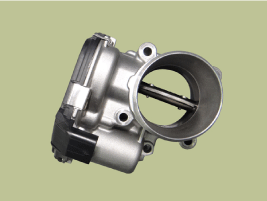
Mounted on throttle body of diesel engine, the air control valve controls the throttle valve according to PWM (Pulse With Modulation) signal from ECM.
It consists of;
a DC motor which actuates the air control valve,
a 2-step gear (transmission ratio = 1:40), located between the DC motor and the air control valve, which increases torque of the DC motor,
a position sensor, a hall-effect sensor, which detects status of the air control valve,
an electric control unit, a micro-controller, which drives the DC motor by the PWM (Pulse With Modulation) signal from the ECM,
and a reset spring which resets the de-energized air control valve to its open position.
Its functions are described below:
Anti-judder function: When the engine is shut off, the ECM prevents inflow of air into intake manifold by fully closing the air control valve for 1.5 seconds (95% < Duty < 97%) to reduce engine vibration.
Intake air control for EGR: When exhaust gas pressure is equal to or lower than intake air pressure (for example, when low engine speed), the exhaust gas cannot enter the intake manifold. In this case, the ECM partially closes the air control valve (5% < Duty < 94%) to reduce the amount of intake air. The intake air pressure thus gets lower than the exhaust gas pressure.
Exhaust gas temperature control for DPF regeneration: When the Catalyzed Particulate Filter (DPF) needs to be regenerated, the ECM partially closes the air control valve (5% < Duty < 94%) to reduce the amount of intake air. In this case, the air fuel ratio would become rich and the exhaust gas temperature would be high enough to burn the soot inside the DPF.
